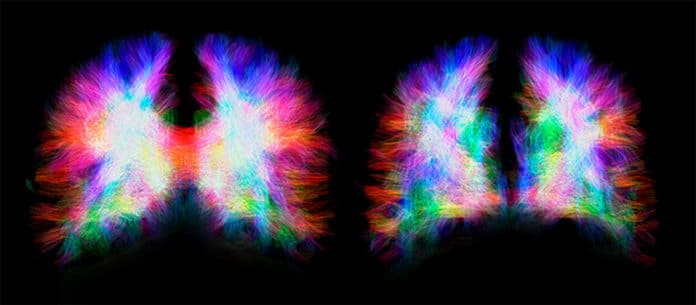The corpus callosum is a large white matter tract that connects the two hemispheres of the brain. It is an incredibly important structural and functional part of the brain. It allows us to perceive depth and enables the two sides of our brain to communicate.
One in 4,000 people is born without a corpus callosum. A quarter of these individuals do not have any symptoms, while the remainder either have low intelligence quotients or suffer from severe cognitive disorders.
People born without a corpus callosum do not have a bridge between the two cerebral hemispheres. A new study has shown how the brain manages to adapt.
The study by the neuroscientists from the University of Geneva discovered that when the neuronal fibers that act as a bridge between the hemispheres are missing, the brain reorganizes itself and creates an impressive number of connections inside each hemisphere. These make more intra-hemispheric connections than in a healthy mind, showing that plasticity mechanisms are included.
Vanessa Siffredi, a researcher in UNIGE’s Faculty of Medicine, said, “Their role in a healthy brain is to ensure the functioning of various cognitive and sensorimotor functions. Surprisingly, 25% of people with this malformation have no visible signs; 50% have average intelligence quotients and learning difficulties, and the remaining 25% suffer from severe cognitive disorders.”
The study has shown that when the corpus callosum is missing, individual fibers act as bridges between the hemispheres, known as Probst bundles. The fibers bypass the absent brain area and curl up inside each hemisphere.
Neuroscientists explain, “The back-up zones vary from one individual to another. And we don’t understand their functions.”
In collaboration with colleagues at the University of Melbourne, scientists in this study set out to understand this variability and examine the fibers’ role. They used MRI brain imaging to study the anatomical and functional links between different brain regions of approximately 20 Australian children aged 8 to 17 suffering from the corpus callosum’s agenesis.
They found that- in children with corpus callosum agenesis, the neural fibers inside each hemisphere are greater in number and higher quality than in healthy brains.
What’s more, scientists successfully determined the correlations between different brain regions’ activity and functional links.
Dr. Siffredi said, “If two regions are active together, it means they are communicating with each other. The data shows that intra and inter-hemispheric functional connectivity of brains without the corpus callosum is comparable to healthy brains. Remarkably, communication between the two hemispheres is maintained. We think that plasticity mechanisms, such as the strengthening of structural bonds within each hemisphere, compensated for the lack of neuronal fibers between hemispheres. New connections are created, and the signals can be re-routed so that communication is preserved between the two hemispheres.”
Scientists also observed the association between the increase in intra-hemispheric connections and cognitive skills. This is quite exciting work since, as agenesis is currently detected by means of ultrasound during pregnancy, it is often proposed that pregnancy be terminated.
Dr. Siffredi said, “In the not-too-distant future, we could imagine using MRI imaging to predict whether the malformation observed by ultrasound runs the risk of being associated with cognitive impairment or not, and so better inform future parents.”
Journal Scientists:
- Vanessa Siffredi et al. Structural Neuroplastic Responses Preserve Functional Connectivity and Neurobehavioral Outcomes in Children Born Without Corpus Callosum. DOI: 10.1093/cercor/bhaa289
